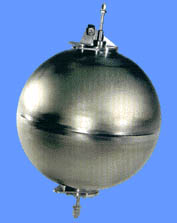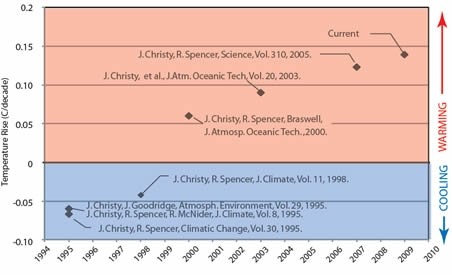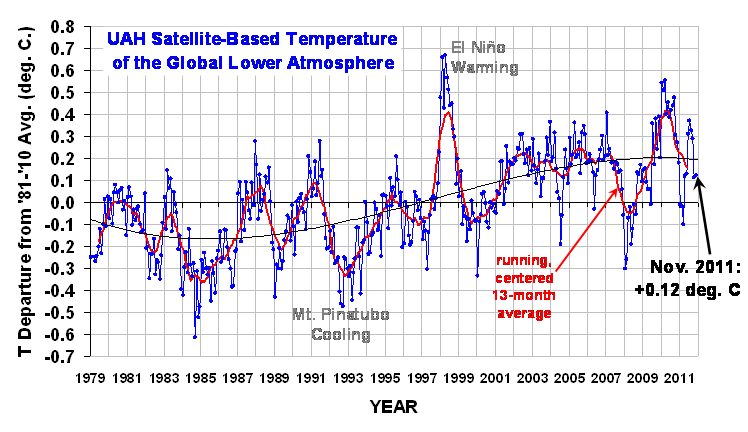
Ned Nikolov’s alternative theory that compression of the lower atmosphere can account for the Earth’s surface temperature being about 33 deg. C higher than calculations suggest it should be (based upon the rate at which sunlight is absorbed) is an admittedly attractive one.
The role of pressure on the average surface temperature of the Earth has been a point of confusion even among atmospheric science and meteorology students (it was for me). We were taught much more about the various processes which cause temperature to *change*, but not so much about the processes which determine what the average temperature *is*.
Background: The Dry Adiabatic Lapse Rate
The dry adiabatic lapse rate of temperature is the rate at which the temperature of a parcel of air decreases with altitude (9.8 deg. C per km) if no energy is gained or lost by that parcel to its surroundings (thus the term “a-diabatic”), or though condensation heating by water vapor (thus “dry”).
It is important to understand that the adiabatic lapse rate deals with temperature *changes* as a result of pressure changes, but it says nothing about what the average temperature will be at any given altitude. It starts with a parcel of air of known temperature, but does not explain why the parcel had that temperature to begin with.
Conceptualizing the Processes Controlling Atmospheric Temperature
The average air temperature at any altitude (including the surface) is an energy budget issue, not an air pressure issue. In fact, energy budget considerations explain the average temperature of just about everything we experience on a daily basis: the inside of buildings, car engines, a pot on the stove, etc.
One useful way to conceptualize the processes determining the time-average surface temperature (neglecting heat transport below the surface) is through this simple thought experiment:
1) start with an atmosphere at absolute zero temperature
2) turn the sunlight on
3) the surface warms as it absorbs solar radiation
4) the warmer the surface gets, the greater the rate at which it loses energy by IR radiation and convection
5) the temperature will eventually stabilize (albeit with a rather large day-night cycle) when the average rate of energy loss equals the average rate of energy gain from the sun.
Note I did not need to mention atmospheric pressure.
While the above steps sound simple, what complicates things in the real world is that these energy gain and loss processes are also occurring at all altitudes, and in different proportions, all of which influence the surface energy budget. This makes it very difficult to conceptualize how they all combine to produce the average temperature profile of the atmosphere observed today.
We (Danny Braswell and I) have found that physical intuition can be built if you construct a “simple” computer program to model the processes in one dimension (vertical). While computer modeling has a bad connotation among many global warming skeptics, it is just putting actual numbers behind hand-waving concepts. If you can’t do that, then all you have left is hand waving.
Many years ago Danny put together such a model so we could examine global warming claims, especially the claim that increasing CO2 will cause warming. The model was indeed able to explain the average vertical temperature structure of the atmosphere. We could initialize the model with an atmosphere at absolute zero, or at an absurdly high temperature, and it would still settle out to about the same temperature profile as is observed in the global average. (I continue to challenge those with alternative theories to do the same).
One of the first things you discover when putting numbers to the problem is the overriding importance of infrared radiative absorption and emission to explaining the atmospheric temperature profile. These IR flows would not occur without the presence of “greenhouse gases”, which simply means gases which absorb and emit IR radiation. Without those gases, there would be no way for the atmosphere to cool to outer space in the presence of continuous convective heat transport from the surface.
Indeed, it is the “greenhouse effect” which destabilizes the atmosphere, leading to convective overturning. Without it, there would not be weather as we know it. The net effect of greenhouse gases is to warm the lowest layers, and to cool the upper layers.
The greenhouse effect thus continuously “tries” to produce a lapse rate much steeper than the adiabatic lapse rate, but convective overturning occurs before that can happen, cooling the lower troposphere and warming the upper troposphere through a net convective transport of heat from lower layers to upper layers.
Now, it’s the downward component of IR radiative flow that many skeptics seem to have a problem with. They ask, how can IR radiation flow from colder temperature at higher altitudes to warmer temperatures at lower altitudes? That would contradict the 2nd Law of Thermodynamics.
Of course, it’s the *net* (upward plus downward) IR flow that must be from higher temperature to lower temperature, and so greenhouse theory does not contradict the 2nd Law of Thermodynamics. If you don’t like the idea of a downward flowing component to the ‘net’, then just conceptualize the effect of greenhouse gases as reducing the rate at which IR energy flows from higher temperature to lower temperature. There, 2nd Law problem solved.
But then, through energy budget considerations, if you reduce the ability of the surface and lower atmosphere to cool in the face of solar heating, the temperature must rise until the rate of energy loss equals the rate of energy gain. This is how greenhouse gases warm the lower atmosphere.
In any event, it is the processes which control the rates of energy gain and loss (not pressure) which determine what the average temperature will be, whether at the surface or any other altitude in the atmosphere.
Thought Experiment #1 on The Pressure Effect
If it is atmospheric pressure which causes the relative warmth of the lower troposphere versus the upper troposphere, then why is the average temperature of the stratosphere virtually constant with height, despite the air pressure at the base of the stratosphere (200 millibars) being about 100x that at the top of the stratosphere (2 millibars)?
If you say it’s due to sunlight absorption by ozone warming the middle and upper stratosphere, you would be correct. But how does the stratosphere then lose all of that extra energy it gains by solar absorption? Well, that occurs through IR emission, primarily from carbon dioxide. The temperature of the ‘ozone layer’ increases until the IR loss (primarily by CO2) equals the rate of solar absorption by ozone. Again, it’s an energy budget issue, not an air pressure issue.
The point I’m making with the stratosphere example is that greenhouse gases are necessary to explain the temperature profile of the stratosphere, not what the “pressure enhancement” theory of climate would predict.
And if greenhouse gases influence the stratosphere, then they must also be operating in the troposphere.
Thought Experiment #2 on the Pressure Effect
Imagine we start with the atmosphere we have today, and then magically dump in an equal amount of atmospheric mass having the same heat content. Let’s assume the extra air was all nitrogen, which is not a greenhouse gas. What would happen to the surface temperature?
Ned Nikolov would probably say that the surface temperature would increase greatly, due to a doubling of the surface pressure causing compressional heating. And he would be correct….initially.
But what would happen next? The rate of solar energy absorption by the surface (the energy input) would still be the same, but now the rate of IR loss by the surface would be much greater, because of the much higher surface temperature brought about through compressional heating.
The resulting energy imbalance would then cause the surface (and overlying atmosphere) to cool to outer space until the rate of IR energy loss once again equaled the rate of solar energy gained. The average temperature would finally end up being about the same as before the atmospheric pressure was doubled.
Conclusion
While I applaud Ned Nikolov’s willingness to advance a controversial alternative, at this point I still must side with the greenhouse effect (despite its terrible name) as an explanation for the average surface temperature of the Earth being considerably higher than that calculated based upon the rate of solar heating of the surface alone.
One of the more significant aspects of the above discussion, which was demonstrated theoretically back in the mid-1960s by Manabe and Strickler, is that the cooling effects of weather short-circuit at least 50% of the greenhouse effect’s warming of the surface. In other words, without surface evaporation and convective heat loss, the Earth’s surface would be about 70 deg. C warmer, rather than 33 deg. C warmer, than simple solar absorption by the surface would suggest.
Thus, weather cools the surface in the face of radiative heating.
And, yes, this effect is included in the climate models used by the IPCC. It would have to be, otherwise the average temperature distributions in those models would be wildly wrong: much too warm in the lower troposphere, and much too cold in the upper troposphere.
I continue to maintain that the major source of error in global warming predictions based upon the IPCC models is not in the physics of the greenhouse effect, but in the realm of feedbacks: especially, how clouds respond to a warming tendency. All of the 20+ models predict clouds will enhance warming; I believe they will reduce warming.
Unfortunately, determining cloud feedbacks from our observations of the climate system is an exceedingly difficult problem. Even more difficult is publishing any evidence of negative cloud feedback in the peer reviewed literature.
Epilogue
Finally, I want to address 3 stumbling blocks which people encounter in all of this.
FIRST, if you are still confused about whether greenhouse gases warm or cool the climate system, let me make the following 2 points:
1) For the atmosphere as a whole, greenhouse gases COOL the atmosphere, through IR radiation to outer space, in the face of heating of the atmosphere by the solar-heated surface.
2) In the process, however, greenhouse gases drastically change the vertical temperature structure of the atmosphere, warming the lower layers, and cooling the upper layers. Think of greenhouse gases as a “radiative blanket”…when you add a blanket over a heat source, it warms the air between the blanket and the heat source, but it cools the air away from the heat source.
Greenhouse gases change the energy budget of all layers of the atmosphere, and it is the energy budget (balance between energy gain and energy loss) which determines what the average temperatures of those layers will be.
SECONDLY, some people claim that IR emission and absorption cannot affect the atmospheric temperature profile because the rate of IR emission and absorption by each layer must be the same.
Wrong.
The rate of absorption of IR by a layer is mostly independent of temperature; the rate of emission, though, increases rapidly with temperature. In general, the rates of IR absorption and emission by atmospheric layers are quite different. The difference is made up by convective heat transport and (especially in the stratosphere) solar absorption.
THIRDLY, if you are wondering, “If temperature change is an energy budget issue, then why does the temperature of an air parcel change when you change its altitude? Doesn’t the temperature change necessarily imply an energy budget change?”
The answer is no.
When an air parcel is raised adiabatically, it’s loss of thermal energy is balanced by an equal gain in potential energy due to its altitude. The ‘dry static energy’ of the parcel thus remains the same, which equals cpT + gZ, where cp is the specific heat capacity, T is temperature in Kelvin, g is the gravitational acceleration, and Z is height in meters.
Of course, averaged over the whole Earth, there can be no net change in altitude; all air parcels rising (and cooling) at any given pressure altitude must be matched by an equivalent mass of air parcels sinking (and warming) at that same pressure altitude.

 Home/Blog
Home/Blog







